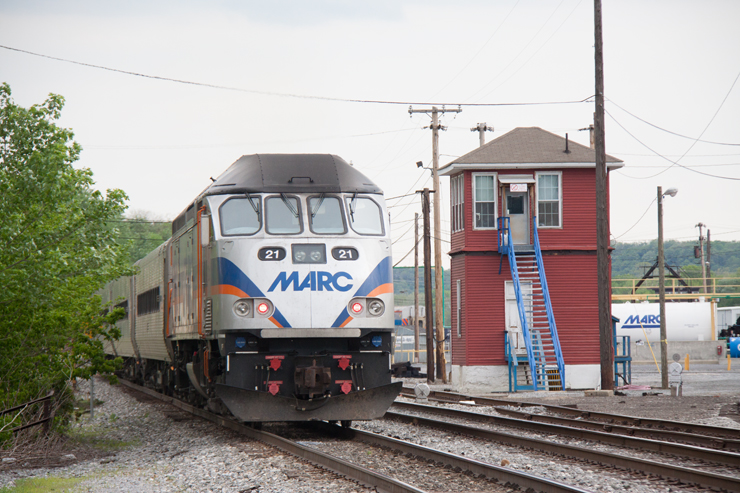WASHINGTON — The two commuter railroads serving the Washington area are experiencing a major drop in on-time performance, and both say increased freight traffic on host railroad CSX Transportation is a significant factor.
The Washington Post reports that Maryland Area Regional Commuter trains and Virginia Railway Express both note there are other factors: hot weather, mechanical issues, and glitches in the roll-out of positive train control. But congestion from CSX traffic is playing a big part.
“There’s just a lot more trains out on the system than there used to be,” Joe Swartz, VRE’s chief of staff, told the Post. “It is not unusual for us to occasionally get caught behind a freight train, and that causes some delays.”
For MARC, on-time performance for the Camden Line, which runs from Washington Union Station to Camden Yards in Baltimore, dropped to 65% in June. On the Brunswick Line, from Union Station to Martinsburg, W.Va., the figure was 73 percent. For VRE, only about 57 percent of trains arrived on time in April and May. That improved to 68% in June, still well short of the 90% target for arrival within five minutes of schedule.
Meanwhile, MARC’s Penn line, which runs on the Amtrak-owned Northeast Corridor, achieved a 91-percent on-time rate.
CSX spokeswoman Cindy Schild told the Post in an email that freight traffic information is proprietary but that she did not believe there had been a year-over-year increase in trains in the Washington Area. “We continue to meet our contractual obligations with our partners and work to improve on-time performance, which minimizes avoidable delays,” Schild wrote.















I was Chief Transportation Officer for MARC for 12 years and I don’t believe it is the number of trains. All it can take is one freight going in emergency to bang 3 or 4 trains. Despite Precision Scheduled Railroading, other than some intermodal trains the rest can vary 2 or 3 hours either way. And if there are two freights going either way then the MARC trains just follow. Just throw in a trespasser strike or a MARC mechanical failure and it adds up. The Brunswick Line is particularly bad because of the steep grades which get freight trains down to 10-15mph. It all runs in a big cycle, earlier this year the Penn Line was abysmal, largely due to mechanical problems. I spend a fair amount of time around the Brunswick Line and if anything the number of trains appears to be down. I’m not saying that CSX couldn’t do better but there rarely was a commitment from them to OTP. I can’t speak for VRE but with 20 Amtrak trains, VRE and CSX trains it’s a pretty busy railroad. Again if there’s only one freight a day and it goes in emergency in the morning rush hour you’ve got big trouble.
One of the items that causes delays for VRE is the two track bridge over the Potomac river. Thirty years ago they talked about building a new two track bridge to parallel the current two track bridge. As soon as the new one was done they would rehab the old one and now have 4 tracks going into DC. Seeing as the freight tracks split off a short distance into DC it would increase capacity. The interesting thing to note is there used to be a lot more traffic with fewer delays when the big R.F+P yard was in Virginia.
I’m guessing the culprit is not number of trains but rather their speed and lack of ‘maneuverability’. Big and slow cant get out of the way of small and fast.
One would think if CSX could “Precision Schedule Railroading” precise scheduling would be a snap. Like scheduling a passenger train.
There has actually been a drop in trains. We have had at least 6 trains cut in the past 2 years.
Or maybe their PSR program schedules the freights at CSX’s preferred times, and to hell with the commuter roads’ schedules.
Puzzling. As I recollect CSX’s Q2-2019 report indicated something like a 1% increase in non-intermodal freight volumes and a double digit decline in intermodal from Q2-2018.
I can’t imagine that minuscule increase resulting in delays to commuter trains. Makes me wonder if CSX has continued to tinker with their internal routing protocols and that is what has led to increased freight traffic on the lines used by MARC and VRE.
Increase in traffic? Really?
Utter CSX hogwash. You wonder why railroads are a public relations disaster. Excuses for poor performance abound. Anyway, I thought business was off? Where is all the traffic coming from?
I thought that tax payer monetywas/is being used to improve capacity to expedite passenger trains. Surely in this case CSX is indebted to such free upgrades and should give a little. Business welfare at its best feeding at the taxpayer ‘trough’ with entitlement.